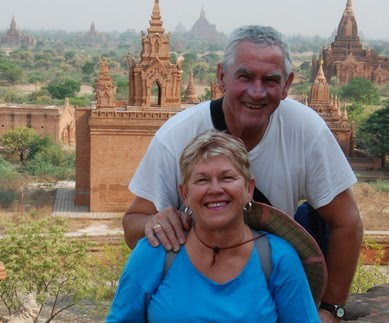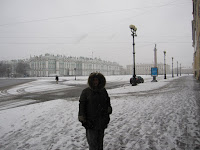
Hello Our next stop is to be a town in the Polish countryside. Our goal is to reach a small town near the German border called Wolsztyn.
Our reason for going to the town. We were sitting talking of our journey on a Sunday morning breakfast prior to our dearture with Voitek our friend. He mentioned he had left Poland as a refugee and he had never been back. The town was Wolsztyn.
So we said "we will go and take a look and take a
 few snaps" So here we go!
few snaps" So here we go!We were not prepared. We had no detailed map of Poland to reference. So we visited the rail information centre in Warsaw. They are marvelous. We discussed our itinerary with them and they printed out some scenarios.
Train to Krakow. OK done that.
Then miss breakfast and catch the 7.45 to Lesno. (Missed our paid breakfast but the train station has ladies cooking up rolls and coffee (much more fun))
On the 7.4
 5 to Lesno. Stopping all stations. ETA 3.10. Lots of locals on and off the train.
5 to Lesno. Stopping all stations. ETA 3.10. Lots of locals on and off the train. The country close to Krakow is coal mining centres with heavy industry. Some of it is left from the Soviet era and is derelict. The country is not pretty but I find that interesting as it is the history of Poland. The Germans controlled this area for 250 years as part of Prussia prior to 1914. Therefore the old villages are Germanic in appearance.
After lunch the scenario changed. The country turns into beautiful rolling farmlands with last years hay still in the fields. Beautiful villages with a church steeple and white washed
 cottages every so often as our train takes its time winding through the country.
cottages every so often as our train takes its time winding through the country. We love this style of train travel. Every so often a tea coffee trolley appears with pastries and good coffee. The locals are friendly and inquisitive about our travel and why we are on this train? Too soon it is 5 minutes to Lesno.
Arrive Lesno 3.11 late. Wolsztyn train due to leave 3.15. Six platforms which one?
Pam gets the count on the hand of a sweeper-porter,
Platform 5
Go Go to
 5 only problem is huge flights of stairs and we are fully packed with all gear.
5 only problem is huge flights of stairs and we are fully packed with all gear.Up the stairs and there in front of us is the little rail engine.
The school bus. Wow says I with camera out catching the scene. "Shiiet" says Pam "get on. Put that stupid thing away". The school kids get the giggles and it is all up hill from there.
The country is rolling farmlands with 15 stops to Wolzstyn. The stations are not stations as such but grass platforms.
Further up the track glasshouses and small crops. Deer graze in the fields, an idyllic site. I think to myself it is easy to see why the Mongols, Swedes, Russians, Germans,
 Austrians last of all the Soviets wanted this land. It grows food and you need food to feed armies and industrial workers. I am a smart Guy! Thanks John
Austrians last of all the Soviets wanted this land. It grows food and you need food to feed armies and industrial workers. I am a smart Guy! Thanks JohnWolzstyn we see the steam engines before we see the town. 25 or so of the huge machines. The town is a living museum of steam as well as Voitek's birthplace (he did not mention the steam bit). Every May the Rail Buffs that love smell of smoke meet and engines come from all countries to celebrate the age of steam. They say 50 engines turn up for the festival and if you like you can hop up on the plate and drive one of these monsters. Awesome.
We find a hotel and start the search
 for Voitek's house. This is a town with a long history. Changed flags so many times since 1155 AD.
for Voitek's house. This is a town with a long history. Changed flags so many times since 1155 AD. The main street is dominated by the train station but also a cemetery with headstones of soldiers telling us that a major battle was fought here in Jan - Feb 1945. The soldiers aged between 18 and 24. I, like others, wonder when will we ever learn?
Then we discover a beautiful lake in the centre of town and by the pictures it is a sailing centre in summer.
The buildings in the main town are two storied shop houses, shingled roofs, timber and masonry framed with narrow winding streets. The town
 is full of charming shops The three churches dominate the skyline Lutheran, Catholic, Orthodox.
is full of charming shops The three churches dominate the skyline Lutheran, Catholic, Orthodox. There is a large house dominating the town square To the right of the large official house is a row of shops and there it is the shop-house as described. Voitek's parent's old shophouse, his birthplace, renovated and looking resplendent.(subject to confirmation by Voitek) Our search is over and it is dark. Decide to photograph in the morning as our train is at 11.45am. Celebration time. I noticed a beaut pub housed in an old building. So in we went
 and had a real merry Polish evening. The best. We love Wolsztyn! Thanks Voitek. What a bonus.
and had a real merry Polish evening. The best. We love Wolsztyn! Thanks Voitek. What a bonus. Next morning. Train to catch. Photographs to take and on to Poznan to connect to the Berlin Express.
Route to travel Berlin a city on the express lane. Then Paris via express\ Then Euro Star to UK and our close friends and the end of the Great Train Journey.
On the road again on the road again. Like a band of Gypsies we go down the highway We're the best of friends
Insisting that the world keep turning our way
Willie Nelson
Image 1 Rail Motor School Bus
image 2 Derelict station
Image 3 Station on the line
Image 4 Big Wheels
Image 5 Wolsztyn station
Image 7 Lake at Sunset
Image 8 Local with his dog
Image 9 Voitek's birthplace house (with rolled arches and dormas)









































